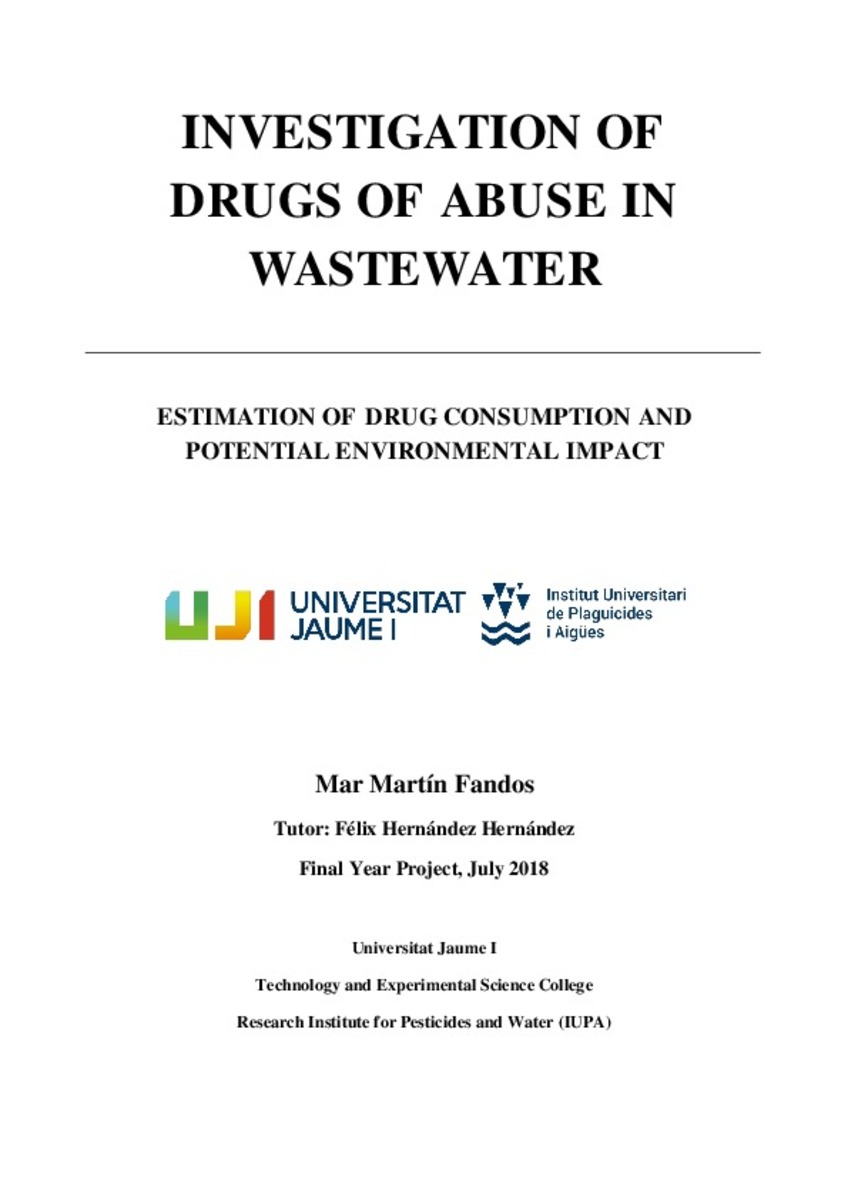Mostrar el registro sencillo del ítem
Investigation of drugs of abuse in wastewater. Estimation of drug consumption and potential environmental impact
| dc.contributor.author | Martín Fandos, Mar | |
| dc.contributor.other | Hernández Hernández, Félix | |
| dc.contributor.other | Universitat Jaume I. Departament de Química Física i Analítica | |
| dc.date.accessioned | 2018-10-01T11:16:10Z | |
| dc.date.available | 2018-10-01T11:16:10Z | |
| dc.date.issued | 2018-07 | |
| dc.identifier.uri | http://hdl.handle.net/10234/176417 | |
| dc.description | Treball Final de Grau en Química. Codi: QU0943. Curs acadèmic: 2017/2018 | ca_CA |
| dc.description.abstract | Drugs of abuse (DOAs) have come to be in the spotlight of the society in recent years. Consumption of these substances can be estimated from the analysis of urban wastewater, as drugs consumed by human beings are finally excreted, mainly in urine, and end up in the wastewater. In addition, when these waters are treated in wastewater treatment plants (WWTPs) there is not a complete removal of compounds such as pharmaceuticals and drugs of abuse; therefore, treated wastewater may have an important impact on aquatic environment. Both issues, the estimation of consumption of DOAs as well as the potential impact on effluent wastewater on the environment, are considered in this study. The study is focused on the determination of several drugs usually consumed and some major metabolites: amphetamine, 3,4-methylenedioxymethamphetamine (MDMA or ecstasy), methamphetamine, 11-nor-9-carboxy-Δ9-tetrahydrocannabinol, cocaine, benzoylecgonine and ketamine. Modern and sensitive analytical methodology based on the ultra-high performance liquid chromatography – tandem mass spectrometry was applied. Solid-phase extraction (SPE) was used for clean-up and to pre-concentrate the samples. To correct for matrix effects, isotope-labelled internal standards, available for all compounds tested, were added to the samples. Moreover, for influent wastewater samples, a four-fold dilution was done before SPE with the aim to facilitate the loading of the samples through the cartridge. The volume of samples injected into the LC-MS/MS system was 3μL. The method applied was previously validated by researchers of the group to ensure the reliability of data reported. The experimental procedure was applied to 14 influent and 14 effluent wastewater samples daily collected from WWTPs of Castellón and Madrid over a whole week. At the same time, removal efficiency of these WWTPs was calculated to estimate the percentage of compound that was not eliminated in the WWTP and consequently was discharged to the aquatic environment generating a potential negative impact. The toxicity of the drugs studied was also considered in the study. | ca_CA |
| dc.format.extent | 41 p. | ca_CA |
| dc.format.mimetype | application/pdf | ca_CA |
| dc.language.iso | eng | ca_CA |
| dc.publisher | Universitat Jaume I | ca_CA |
| dc.rights | Attribution-NonCommercial-NoDerivatives 4.0 Internacional | * |
| dc.rights.uri | http://creativecommons.org/licenses/by-nc-nd/4.0/ | * |
| dc.subject | Grau en Química | ca_CA |
| dc.subject | Grado en Química | ca_CA |
| dc.subject | Bachelor's Degree in Chemistry | ca_CA |
| dc.title | Investigation of drugs of abuse in wastewater. Estimation of drug consumption and potential environmental impact | ca_CA |
| dc.type | info:eu-repo/semantics/bachelorThesis | ca_CA |
| dc.educationLevel | Estudios de Grado | ca_CA |
| dc.rights.accessRights | info:eu-repo/semantics/openAccess | ca_CA |
Ficheros en el ítem
Este ítem aparece en la(s) siguiente(s) colección(ones)
-
Grau en Química [265]
QU0943








